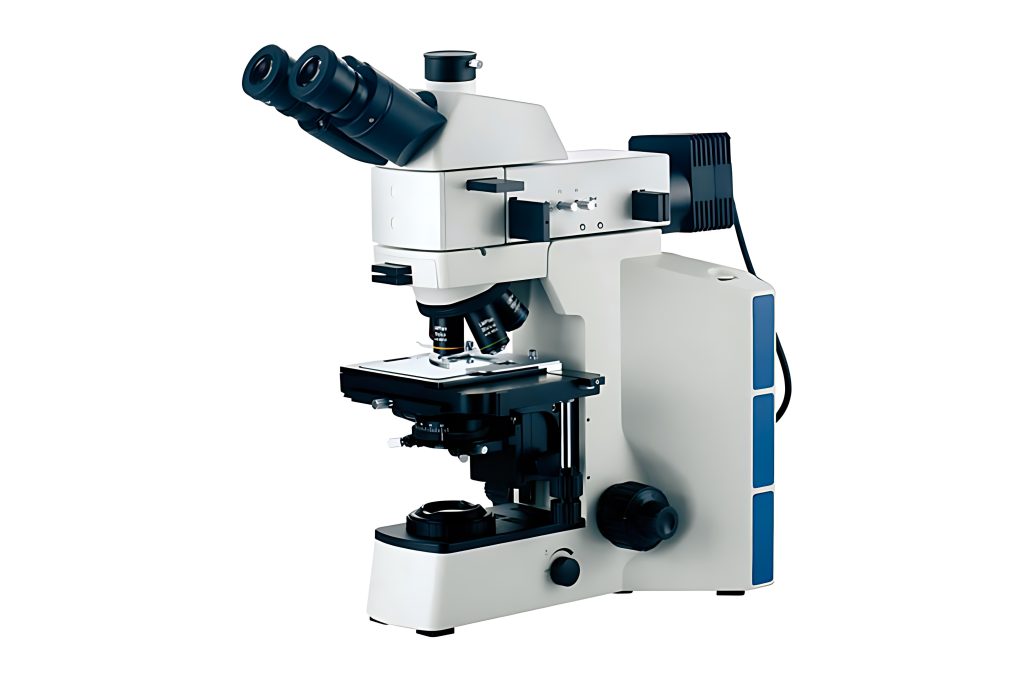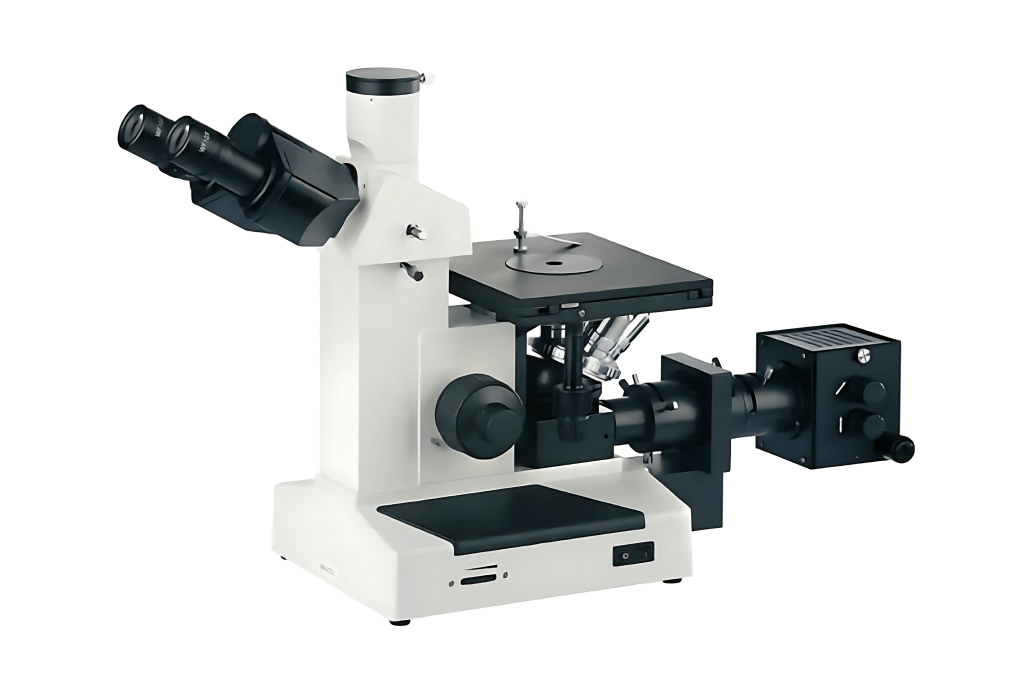The metallographic microscope system organically combines a traditional optical microscope with a computer (digital camera) through photoelectric conversion. Not only can microscopic observations be made on the eyepiece, but also real-time dynamic images can be observed on the computer (digital camera) display screen. , computer-based metallographic microscope and can edit, save, and print the required pictures.
A metallographic microscope is mainly composed of an optical system and an illumination system. The optical system includes eyepieces, relay systems, and objectives.
Typical applications include grain size, inclusion counting, layer thickness assessment and phase determination. Some models have special facilities, such as darkfield and DIC, that provide improved observation techniques for certain classes of specimens.
Metallographic microscopes all have polarized light capabilities, a range of filters, and camera ports for photography and image analysis; some upright models have both incident and transmitted light for use with more transparent materials.
Four illumination systems commonly used in metallographic microscopes
The lighting system is an important part of the metallographic microscope. Currently, the commonly used light sources include tungsten filament incandescent lamps, halogen lamps, carbon arc lamps, and xenon lamps.
- Tungsten filament incandescent lamp: Generally, small and medium-sized microscopes are equipped with low-voltage tungsten filament lamps. The working voltage is generally 6~8V. It is adjusted with a small voltage regulator and the power is 15~100W. This kind of lamp is suitable for metallographic structures. observe.
- Halogen lamp (tungsten halogen lamp): The low-voltage incandescent tungsten lamp used for observation in metallographic microscopes has gradually been replaced by halogen lamp. This is because when the tungsten filament in an ordinary light bulb emits incandescence, the tungsten on the surface will evaporate, diffuse and accumulate on the light bulb, causing the light bulb to turn black and reduce the lighting brightness. At the same time, the filament will gradually become thinner and even break. If a small amount of iodine is added to the bulb through the so-called “iodine-tungsten cycle”, the above defects can be effectively avoided. The bulb of the tungsten halogen lamp must be made of high-temperature resistant quartz glass.
- Carbon arc lamp: The carbon arc lamp of a metallographic microscope uses two carbon rods exposed to the air and close to each other. After being energized, a strong arc is generated to emit very bright light. Generally, AC power supply is used, but this will cause arc flashing and unstable light source, which is especially unfavorable for photography. This is its main shortcoming.
- Xenon lamp: A xenon lamp is a quartz glass tube equipped with a tungsten electrode and filled with high-voltage xenon gas, which uses discharge to emit light. It is characterized by high light intensity, stable output and long life. In addition, xenon lamps have a continuous spectrum similar to sunlight and can be used for color photography. The xenon lamp is one of the latest light sources for metallographic microscopic observation, but special attention must be paid to safety when using the xenon lamp.
The lighting system consists of a high-intensity light source, condenser lens, aperture diaphragm and plane glass reflector. The lighting system may also include colored or polarizing filters. Green filters are often used to improve detail and polarizing filters to create surface glare and improve grain boundary clarity.
The aperture diaphragm is used to control the amount of light entering the objective lens, and the field diaphragm is used to minimize internal glare within the microscope and enhance the contrast of various components in the specimen. The quality of the objectives used in a microscope is probably the most critical factor affecting image quality. The objective lens should be properly matched to the eyepiece to obtain the best quality image.
Optical system of metallographic microscope
The optical system of a metallographic microscope mainly consists of eyepieces, relay systems, objective lenses, and other components.
The magnification of the objective and eyepieces are engraved on the lens mount. The total magnification of a microscope can be determined by finding the product of the eyepiece and objective magnifications. For example: a 5X magnification eyepiece combined with a 40X objective lens can provide a magnification of 200X. The maximum magnification of an optical microscope is limited to around 2000X. Higher magnification does not show more details and is called “empty magnification”. Contrary to popular belief, high magnification does not necessarily reveal fine detail. The numerical aperture or light-gathering ability of a lens largely determines the ability to resolve fine details.
Metallurgical microscopes are divided into two types according to their structure:
- Upright microscope: The objective lens is located above the specimen. This is the most commonly used type.
- Inverted microscope: The objective lens is located below the specimen, allowing larger specimens to be observed
Metallographic upright microscope

An upright microscope is characterized by an illumination system mounted above the specimen stage so that light passes through the objective lens onto the specimen and is then reflected back to the eyepiece.
These types of instruments are also commonly referred to as upright compound microscopes and upright materials microscopes.
Upright microscopes are available on two types of stands, traditional microscope stands and pillar stands, the latter offering excellent flexibility and allowing for larger sample sizes.
Upright microscopes come standard with polarized light and filters.
Other common features include:
- Three-eye gimbal that can be connected to cameras and image analysis
- Dual 10x wide field eyepieces (optional 15X)
- Paired rubber eyeguards
- Adjustable interpupillary distance comfortably adapts to every user
- Diopter adjustment makes each microscope suitable for glasses and glasses wearers
- Stand for inserting the analyzer/polarizer and directing the image to the camera port
- Fully filled rotating filter wheel or filter slider
- Adjustable light position (not required for LED).
- Adjustable intensity control
- LED and halogen lighting options, and fixtures equipped with darkfield microscopy must be very bright
- Plan achromatic infinity-corrected objective lens
- DIC option on some microscopes
- Metallurgical specimen holder with mechanical stage and lowering side control device.
- Some models can have transmitted and incident light for complete versatility
Metallographic inverted microscope

The characteristic of the inverted microscope is that the illumination system is installed under the sample stage so that the light is guided to the sample through the objective lens and then reflected back to the eyepiece. It is a microscope used for metallographic analysis of materials and has many unique advantages and features.
Advantages and features of metallographic inverted microscopes:
- Inverted structure: Compared with traditional metallographic microscopes, its optical path is inverted. This means that the sample is placed above the microscope, while the objective and lens are below the sample. This inverted structure makes observation and operation more convenient, especially suitable for large or irregular samples, such as metal blocks, castings, etc.
- Large working distance: Usually has a large working distance, that is, the distance from the objective lens to the sample. This design allows greater height or thickness to be accommodated for specimens placed underneath the microscope. For samples that require welding, grinding, coating and other processing operations, the large working distance can provide enough space.
- Light path stability: The inverted structure of the inverted metallographic microscope also helps maintain the stability of the light path. Since the objective lens is located below the sample, its position is relatively fixed and is not easily affected by vibration or sample displacement. This is important for metallographic analysis where high magnification observations and measurements are required.
- Wide application: Can be adapted to various types of metallographic analysis needs. For example, it is suitable for the observation of large samples, such as metal castings, semiconductor wafers, etc. It can also be used to observe biological materials or cell cultures in liquid environments, as the sample can be placed directly on the microscope stage.
- Easy to operate and adjust: Usually equipped with lenses with multiple viewing angles, allowing the sample to be observed from different directions. In addition, there are various optical adjustment devices, such as condenser, polarizing, bright field and dark field illumination systems, to meet different observation needs.
- High resolution and magnification: Usually have excellent optical performance, including high resolution and adjustable magnification. This enables users to observe and analyze important features such as the material’s microstructure, grain morphology, defects, etc.
The inverted metallographic microscope is a flexible and powerful tool widely used in materials science, metal processing, semiconductor manufacturing and other fields. Its inverted structure, large working distance, optical path stability and strong adaptability make the microscope an indispensable equipment in many metallographic analysis laboratories and industrial practices.